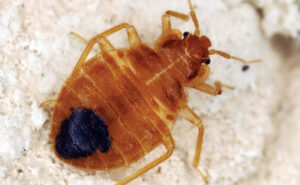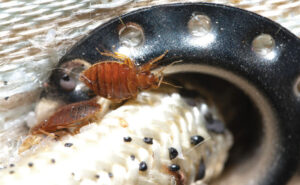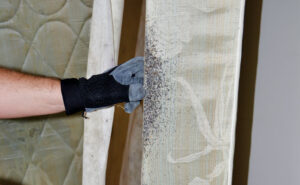Research findings continue to shape strategies for this public health pest
In recent years, bed bugs have reemerged as a substantial challenge for the professional pest management industry1. Despite Cimex lectularius’ resilience to various eradication methods, the scientific community is actively involved in pioneering research to address these challenges. One such example is learning how bed bug histamine could cause humans skin and breathing issues in infested spaces.

Per the National Pest Management Association, bed bugs “can ingest seven times their own weight in blood, which would be the equivalent of an average-sized male drinking 120 gallons of liquid.” (Photo: Tomasz Klejdysz / iStock / Getty Images Plus / Getty Images)
Tackling insecticide resistance
The challenge of insecticide resistance among bed bugs has led to the development of several innovative solutions to address this issue. Alternative approaches include:
▶ Heat treatment. A 2011 study2 explored the temperature and time requirements for controlling bed bugs under commercial heat treatment conditions. The findings revealed that both adult bed bugs and their eggs can be eliminated by heat, with adult bugs perishing at 119 degrees Fahrenheit and eggs at 130 degrees Fahrenheit. Exposing adult bed bugs to 113 degrees Fahrenheit for 94.8 minutes is lethal, while eggs survive only seven hours at this temperature and 71.5 minutes at 118.4 degrees Fahrenheit.
Pest management professionals (PMPs) leverage this knowledge to conduct whole-room heat treatments using commercial heaters and powerful fans, thereby increasing bed bug mortality rates through convection currents.
In recent years, successful heat treatments have been performed in various settings, including homes, apartments, hospitals, vehicles and ambulances. However, these treatments necessitate careful preparation and customer cooperation. While heat treatment leaves no residue, in some cases, PMPs may need to strategically apply approved pesticides to maintain protection against bed bugs. The presence of concrete that absorbs heat also can impact treatment effectiveness, particularly in heavy bed bug infestations where bugs are concealed deep within wall or floor voids.

Two bed bugs crawl around a grommet for a mattress handle. Look closely among their feces, and you’ll see a couple of translucent bed bug eggs, too. Photo: © Gene White
▶ Essential oils. Essential oils are showing some promise3 in combating bed bugs. Among them, blood orange has been identified as one of the most effective, highlighting their potential as eco-friendly bed bug control agents. This complements findings from a 2014 study4, which explored the efficacy of essential oil-based pesticides and detergents for bed bug control. These investigations underscore the increasing importance of essential oils as green alternatives for managing bed bug infestations, offering options for any customers concerned about exposure to chemical insecticides.
▶Insect-killing fungi. In recent years, insect-killing fungi such as Beauveria bassiana have shown promise in controlling bed bugs5. Experiments have demonstrated significant improvements in bed bug mortality rates with different formulations and doses. Factors such as substrate type and application strategy influence its effectiveness, with multiple applications over time enhancing efficacy, especially on soft substrates like cotton and polyester.
Integrating these fungi into pest management strategies offers a sustainable approach to combating bed bug infestations.
Optimizing environmental factors
Environmental factors play a pivotal role in the effectiveness of control methods. Notably, moisture levels affect the performance of insecticide dust formulations used in concealed spaces and crevices. A 2020 study6 demonstrated that exposure to steam significantly diminished the effectiveness of insecticide dust. This underscores the importance of considering moisture levels when applying insecticide dust in real-world pest management strategies.

Mattresses and box springs are the most common harborage areas for bed bugs, but are far from the only ones. Make sure to inspect furniture, drapes, luggage, picture frames and more. Photo: © Gene White
Enhancing detection, identification and monitoring
A multifaceted approach to bed bug management emphasizes early detection and health-related concerns. For example, recently developed rapid bed bug tests are designed to provide swift and precise identification of infestations on-site. Visual inspections remain a fundamental component of a comprehensive assessment, however.
Moreover, understanding the climbing behavior of bed bugs is crucial. A 2017 study7 highlighted significant disparities in climbing capabilities between common bed bugs (C. lectularius) and tropical bed bugs (C. hemipterus). Accurate species identification is essential, as mistaking one species for another can lead to ineffective control measures because of differences in climbing behavior.
Recent innovations in bed bug research offer valuable insights and strategies for more effective bed bug control. These discoveries — encompassing genetics, behavior, resistance patterns and environmental factors — inspire confidence that an environment free from bed bug nuisances can be restored to customers.
Bed bug histamine excretion is new study focus
Recent research has enhanced our understanding of bed bug infestations. In 2023, Principato et al.* conducted a groundbreaking study that revealed histamine excretion by arthropods, particularly bed bugs. Bed bugs excrete histamine within their feces, serving as an aggregation pheromone, which contaminates indoor environments.
The human health risks associated with indoor histamine are not yet fully understood, but this study highlights its prevalence among “hematophagous hemipterans” (blood-feeding insects in the order Hemiptera), particularly bed bugs. This discovery offers opportunities for targeted monitoring, improved preventive measures and enhanced health considerations in bed bug management.
References
1. Potter, M.F. (2008). “The business of bed bugs,” Pest Management Professional. 76(1): 24-40.
2. Kells, S.A., and M.J. Goblirsch. (2011). “Temperature and time requirements for controlling bed bugs (Cimex lectularius) under commercial heat treatment conditions.” Insects. 2(3): 412–422. Doi: 10.3390/insects2030412.
3. Zha, C., Wang, C., and Li, A. (2018). “Toxicities of Selected Essential Oils, Silicone Oils, and Paraffin Oil against the Common Bed Bug (Hemiptera: Cimicidae).” Journal of Economic Entomology, (111:1), February 2018, 170–177. Doi: 10.1093/jee/tox285.
4. Singh, N., Wang, C., and Cooper, R. (2014). “Potential of Essential Oil-Based Pesticides and Detergents for Bed Bug Control.” Journal of Economic Entomology, 107(6), 2163–2170.
5. Aak, A., Hage, M., and Rukke, B.A. (2023). “Biological control of Cimex lectularius with Beauveria bassiana: Effects of substrate, dosage, application strategy, and bed bug physiology.” Pest Management Science. Doi: 10.1002/ps.7659.
6. Ranabhat, S., and Wang, C. (2020). “Effect of Moisture on Efficacy of Selected Insecticide Dusts Against the Common Bed Bug, Cimex lectularius (Hemiptera: Cimicidae).” Journal of Economic Entomology, 113(4), 1933–1939.
7. Kim, D-Y., Billen, J., Doggett, S.L., and Lee, C-Y. (2017). “Differences in Climbing Ability of Cimex lectularius and Cimex hemipterus (Hemiptera: Cimicidae).” Journal of Economic Entomology, 110(3), 1179-1186.
* Principato, M.A., Skinner, A., Kumar, S., Campanella, A., Bernal, J.A., and Gibb, T.J. (2023). “Bed bugs excrete histamine in their feces, revealing a potential issue in indoor environments.” PLoS ONE, 18(3), e0265496.
Leave A Comment